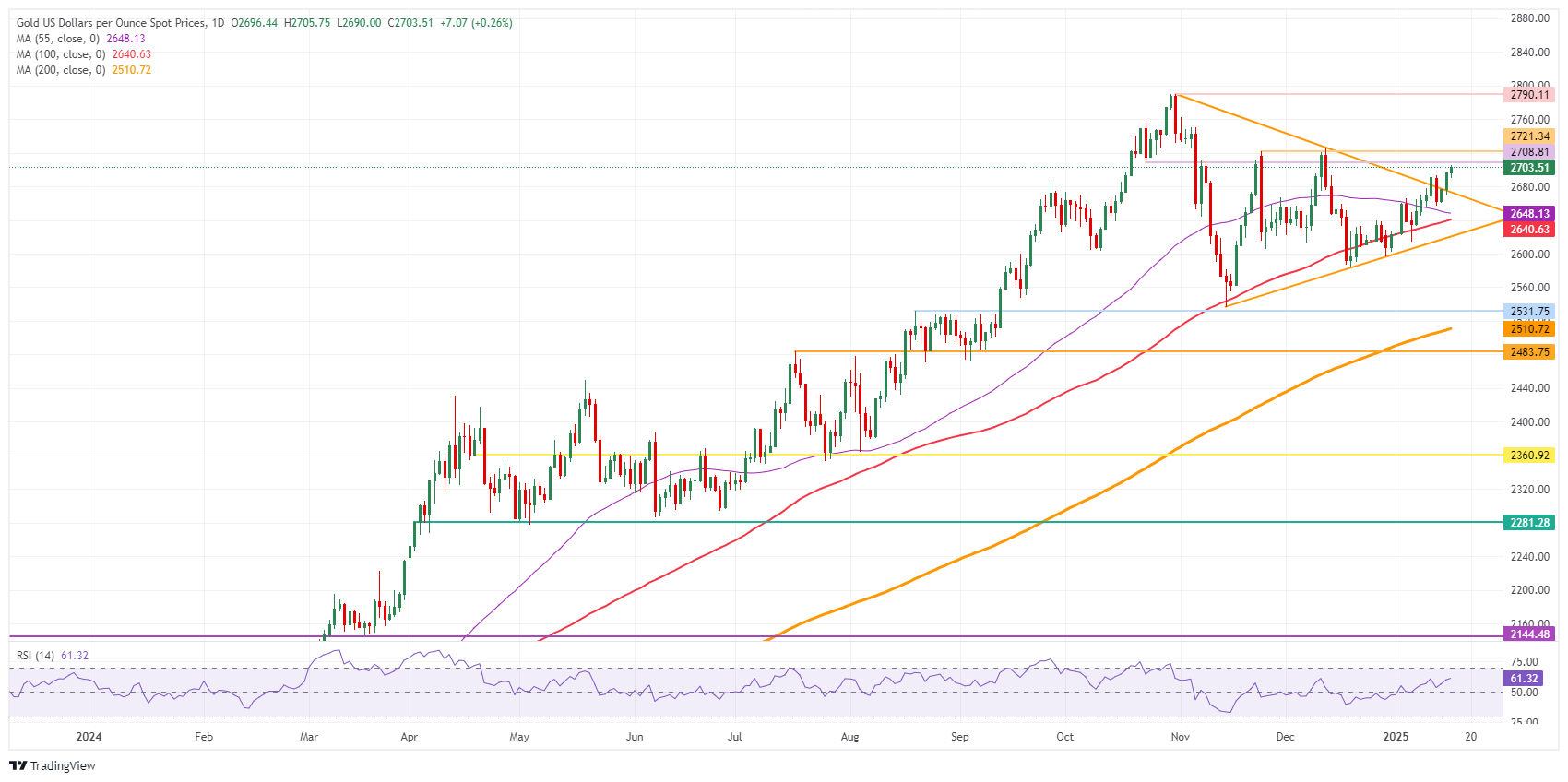- The price of Gold extends its recovery and rises above $2,700, seeking further increases.
- The mixed US CPI release on Wednesday fueled hopes of a Fed rate cut before the summer.
- Gold shoots up and is heading towards the first major pivotal level at $2,708.
The price of Gold (XAU/USD) rises for the third day in a row and recovers the initial losses of the week, surpassing the $2,700 level at the time of writing on Thursday. The recovery comes in the run-up to and release of US Consumer Price Index (CPI) data for December on Wednesday.
While the headline CPI accelerated compared to the previous month, core inflation rose at a slower pace than in November, increasing the likelihood of a 25 basis point (bps) rate cut by the Federal Reserve (Fed) in June. According to the CME FedWatch tool, the odds that interest rates will be lower than current levels after the June meeting stand at 63.8%, compared with 57.3% before the inflation data and 51.4% on Monday.
On the economic data front, US initial jobless claims for the week ending January 10 and December import/export and retail sales data will be released on Thursday. Meanwhile, US Treasury yields are falling further, with the benchmark 10-year yield trading below 4.70%.
What moves the market today: Where is the Fed when you need it?
- Despite several Federal Reserve speakers on Wednesday, officials did not communicate much market-moving commentary on whether market expectations were wrong or in line with Fed policy.
- At 13:30 GMT, December retail sales will be released with expectations for a monthly increase of 0.6% compared to 0.7% the previous month. As always, the reviews could be more shocking than the actual number.
- South African rescue workers recovered 78 bodies from an abandoned gold mine where hundreds of illegal miners have been involved in a months-long standoff with authorities, Bloomberg reports.
- The US 10-year bond yield is trading around 4.667%, more than 2.5% below its peak yield this week on Tuesday at 4.807%.
Technical Analysis: Here comes the difficult part
Gold bulls face their first litmus test on the upside on Thursday, with strong resistance around the pivotal level of $2,708, followed by $2,721. The Relative Strength Index (RSI) is rising rapidly on the daily chart. The risk of an overheating of the RSI momentum indicator by the time Gold reaches that $2,720 area could see a quick correction back to $2,680.
The first support is the descending trend line on the pennant chart formation, which has been discussed several times in recent days. That level is currently around $2,671. Should further decline occur, the 55-day SMA at $2,648 is the next support, followed by the 100-day SMA at $2,640.
To the upside, the October 23 low at $2,708 is the key pivotal level to watch. Once that level is broken, $2,721, which is a sort of double top in November and December of last year, is rapidly approaching. Should Gold break above that level, the all-time high of $2,790 is the key bullish barrier.
XAU/USD: Daily Chart
Gold FAQs
Gold has played a fundamental role in human history, as it has been widely used as a store of value and medium of exchange. Today, apart from its brilliance and use for jewelry, the precious metal is considered a safe-haven asset, meaning it is considered a good investment in turbulent times. Gold is also considered a hedge against inflation and currency depreciation, since it does not depend on any specific issuer or government.
Central banks are the largest holders of Gold. In their aim to support their currencies in turbulent times, central banks tend to diversify their reserves and purchase Gold to improve the perception of strength of the economy and currency. High Gold reserves can be a source of confidence for the solvency of a country. Central banks added 1,136 tons of gold worth about $70 billion to their reserves in 2022, according to data from the World Gold Council. This is the largest annual purchase since records exist. Central banks in emerging economies such as China, India and Türkiye are rapidly increasing their gold reserves.
Gold has an inverse correlation with the US Dollar and US Treasuries, which are the main reserve and safe haven assets. When the Dollar depreciates, the price of Gold tends to rise, allowing investors and central banks to diversify their assets in turbulent times. Gold is also inversely correlated with risk assets. A rally in the stock market tends to weaken the price of Gold, while sell-offs in riskier markets tend to favor the precious metal.
The price of Gold can move due to a wide range of factors. Geopolitical instability or fear of a deep recession can cause the price of Gold to rise rapidly due to its status as a safe haven asset. As a non-yielding asset, the price of Gold tends to rise when interest rates fall, while rising money prices tend to weigh down the yellow metal. Still, most of the moves depend on how the US Dollar (USD) performs, as the asset is traded in dollars (XAU/USD). A strong Dollar tends to keep the price of Gold in check, while a weaker Dollar is likely to push up Gold prices.
Source: Fx Street
I am Joshua Winder, a senior-level journalist and editor at World Stock Market. I specialize in covering news related to the stock market and economic trends. With more than 8 years of experience in this field, I have become an expert in financial reporting.








